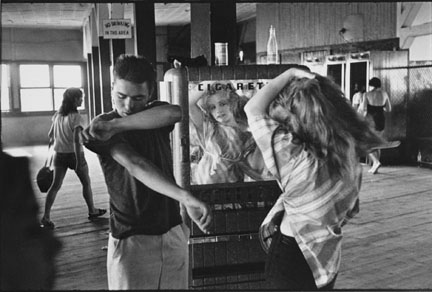About the Photographer
Davidson, Bruce
American, b. 1933 Oak Park, IL
Bruce Davidson is one of the most influential American documentary photographers of the twentieth century. He began taking photographs at the age of ten in his hometown of Oak Park, Illinois. Davidson attended the Rochester Institute of Technology and Yale University. Davidson met Henri Cartier-Bresson, an influence on Davidson and the co-founder of Magnum Photos, after he was drafted into the army and stationed near Paris in 1955. Davidson left the military in 1957 and worked for LIFE magazine as a freelance photographer, and in 1958 he became a full member of Magnum Photos.
Joining Magnum began a prolific and important period in Davidson’s early career, during which he documented a traveling circus, including his famous image “The Dwarf,†and, subsequently, a Brooklyn youth gang called the Jokers. Later published as a monograph in 1998, Brooklyn Gang proved to be a seminal body of work for Davidson, who stated, “Brooklyn Gang is always an underpinning. The Brooklyn Gang series is not really about gangs; it’s about emotionality and tension, abuse and abandonment.†In 1962 Davidson received a Guggenheim Fellowship to document the Freedom Riders of the Civil Rights Movement, during which time Davidson solidified his up-close approach to insider reportage: “I made a decision early on not to buy a telephoto lens, to never be more than a metre and a half from the protesters and the policemen I was photographing on the streets. I wanted to be almost in the picture.†The Museum of Modern Art in New York exhibited Davidson’s early work in 1963.
The MoCP permanent collection features Davidson’s portfolio of the coalfield communities in South Wales, United Kingdom, shot in ten days in 1965 and considered to be one of the most significant bodies of work on the region. In the “Welsh Miners†portfolio Davidson continued his personal approach to documentary work, seeking not just to capture the poverty and struggle of living in this region, but also what he called its lyrical beauty: “There was a certain beauty in all that darkness and I wasn’t there to make any kind of political statement – I was there to find something beautiful in the people and in their work… I wasn’t there to photograph the poverty, but the beauty I found as an artist.†In 1966 Davidson received the first grant for photography from the National Endowment for the Arts and subsequently used a large format camera to document one block of Harlem, New York, over the course of two years. The resulting “East 100th Street†series is an astonishingly intimate photo-essay of life in the city. A monograph of this work was published in 1970 and was the subject of a solo exhibition at the Museum of Modern Art in New York the same year. In 1998 Davidson received an Open Society Institute Individual fellowship to return to Harlem and document the changes.
Davidson turned to color photography in 1980 with his “Subway†series in New York, exhibited at the International Center of Photography in 1982 and published as a monograph in 1986. In the 1990s he began photographing Central Park, followed by a series of urban landscapes in Paris and Los Angeles in the 2000s. Davidson’s numerous awards include the Lucie Award for Outstanding Achievement in Documentary Photography (2004) and a Gold Medal Lifetime Achievement Award from the National Arts Club (2007). Bruce Davidson: Outside Inside, a three-volume box set of over 800 photographs spanning Davidson’s career, was published in 2010. The title is reflective of Davidson’s approach to photography: “I start off as an outsider, usually photographing other outsiders, then, at some point, I step over a line and become an insider. I don’t do detached observation.†Davidson is an active member of Magnum Photos and continues to live and work in New York as an editorial and documentary photographer.




